
The meticulous process of staking on Ledger not only fortifies your transaction validations on a proof-of-stake blockchain but also propels your investment journey by allowing you to accrue additional assets.
With Ledger, renowned for its top-tier hardware wallets – Nano X and Nano S, you’re not just staking; you’re ensuring that your digital currencies are shielded while simultaneously reaping rewards from your staked coins.
This article unfolds the step-by-step guide on how to seamlessly stake coins on Ledger Wallet, exploring the multifaceted approaches to generate revenue through staking, and diving deep into the world where your assets do not just remain idle but work in favor of enhancing your financial growth in the crypto universe.
Let’s unveil the strategic insights into optimizing Ledger staking for a prosperous cryptocurrency endeavor.
| Step | Description |
|---|---|
| 🔗 Connect your Ledger Wallet to your computer | To do this, you’ll need to use the USB cable that came with your Ledger device. Once connected, open the Ledger Live application on your computer. |
| 🪙 Open the application corresponding to the coin | Each cryptocurrency has its own application on the Ledger Live platform. For example, if you’re staking Ethereum, you’ll need to open the Ethereum application. |
| 🧭 Navigate to the staking or delegation section | This will depend on the specific cryptocurrency. For Ethereum, for example, you would go to the “Earn” section and select “Stake”. |
| 📊 Select amount and validator | You’ll need to enter the amount of coins you want to stake and select the validator from the list. |
| ✍️ Sign the transaction | Your Ledger device will ask you to confirm the transaction. Make sure to double-check all the details before confirming. |
| ⏳ Wait for transaction processing | This can take some time, depending on the network congestion and the specific cryptocurrency. |
Staking is the process of participating in transaction validation on a proof of stake blockchain. Cryptocurrency investors can opt into staking, allowing them to earn more with their digital assets.
There are many popular staking coins but three of them are surely sparking the most interest among crypto users so we covered the staking process for all three of them:
Ethereum staking explained, Cardano staking guide and Algorand staking guide.
What you'll learn 👉
Why stake with Ledger?
Ledger is considered the industry standard for hardware wallets. It has two very popular models: Nano X and Nano S.
A hardware wallet is simply a way to store your cryptocurrency offline, safeguarding it from hackers. The advantage of staking with Ledger is that you maintain complete control of your assets whilst staking, meaning there is no need to deposit them to an exchange or online wallet to earn.

Ledger also supports staking for up to 7 different cryptocurrencies simultaneously, making it possible for anyone with a diverse portfolio to earn rewards on multiple assets with the same wallet.
Read also: How good is the latest Ledger Nano S Plus? Check out our review and also direct comparison of Nano S Plus vs Nano S / Nano S Plus vs Nano X.
Staking on Ledger – How to stake coins with Ledger Live
Ledger Live is a user interface app made for use with Ledger wallets. Ledger Live allows you to create a personal account that will enable you to view and manage your assets.
Staking cryptocurrency with Ledger Live is an easy process; you can start staking cryptocurrency in a few steps:
- Install the Ledger Live app
- Create an account on Ledger Live
- Inside the app, find the app for the specific coin you wish to stake
- Transfer funds to your device using Ledger Live
- Start staking and earn rewards on your assets
Coinbase ETH Staking Integration (February 2025)
US users can now access Coinbase’s ETH staking pools directly through Ledger Live, enabling pooled staking with as little as 0.001 ETH (vs. Ethereum’s standard 32 ETH requirement). This integration allows users to earn daily ETH rewards while maintaining self-custody via Ledger devices.
How to stake coins with Ledger + external wallets
- Install the crypto app on your Ledger device
- Choose the third party wallet you wish to use
- Add funds to your device using the selected wallet
- Start staking and earn rewards
Cryptos to Stake with Ledger
| Coin Name | APY Range | Notes |
|---|---|---|
| Ethereum (ETH) | Up to 3.5% | Stake via Ledger Live using providers like Lido or Kiln. |
| Solana (SOL) | Up to 5% | Stake through Ledger Live with Ledger by Figment validator. |
| Polkadot (DOT) | Up to 11.5% | Stake via Ledger Live. |
| Tezos (XTZ) | Varies | Stake through Ledger Live. |
| Cosmos (ATOM) | Varies | Stake via Ledger Live. |
| Algorand (ALGO) | 10.02%–14.05% | Participate in governance via MyAlgo wallet; Ledger Live does not support governance rewards. |
| Avalanche (AVAX) | Around 8% | Stake by pairing Ledger with Avalanche Wallet; requires a minimum lock-up period of 14 days. |
| NEAR Protocol (NEAR) | Up to 11.5% | Stake via Ledger Live. |
| Cardano (ADA) | Varies | Stake through Ledger Live. |
| Tron (TRX) | Varies | Stake via Ledger Live. |
| Celo (CELO) | Varies | Stake via Ledger Live. |
| Osmosis (OSMO) | Varies | Stake via third-party wallets compatible with Ledger. |
| MultiversX (EGLD) | Varies | Stake via third-party wallets compatible with Ledger. |
Different Ways to Generate Revenue by Staking
Claiming
Staking coins for a set period allows you to get rewards according to the amount of cryptocurrency used for staking.
Staking rewards vary for each asset, and you will typically receive rewards monthly.
Delegating or Nominating
Another option is to delegate or nominate part of their stake to a validator responsible for securing the network. Rewards will come from the validator as they share part of the revenue they earn with anyone who is nominating/delegating their stake to them.
In most cases, the protocol can automatically pay these kinds of rewards. With some assets, the validator is responsible for sharing the rewards.
Running validators
Running validators involves running a node to help secure the network.
Validators receive rewards corresponding to how much cryptocurrency they stake.
Validators can also build a pool of cryptocurrency, allowing other investors to contribute assets to the validator. The validator will then share the rewards with anyone who adds cryptocurrency to the pool.
Difference between PoW and PoS
Proof of Work
Bitcoin is an example of a blockchain that uses the proof of work system. Transactions on the network take around 10 minutes before they are validated. During this 10-minute interval, a new “block” is made and added to what is known as the blockchain.
Every block in the network contains different transactions, which must be validated. The Bitcoin network achieves this with the help of miners, who use their computational power to solve a complex algorithm; this process is called proof of work.
Miners compete to solve these algorithms; whichever miner completes the task first will receive the reward.
Proof of Stake
Proof of stake is another type of mechanism used by blockchain networks to achieve distributed consensus.
Proof of Stake requires users to stake cryptocurrency to become a validator in the network. Validators are the equivalent of a miner in the proof of work mechanism.
Proof-of-stake makes some improvements to the proof of work system
- More energy efficient – Less energy is required as there is no need to mine new blocks.
- More accessible – Proof of stake makes it easier for cryptocurrency enthusiasts to earn rewards from their assets
- More immune to centralization – Proof of stake leads to more nodes in the network
With the proof of stake model, validators are more likely to earn rewards related to how much cryptocurrency they stake.
Staking more assets means more rewards.
Conclusion on Ledger staking
Staking allows cryptocurrency investors to make more with their digital assets. Stakers earn rewards based on how much cryptocurrency they contribute towards the proof of stake model. The Ledger wallet provides an excellent introduction into the world of staking, allowing users to earn rewards on several cryptocurrencies whilst also providing a high level of security for their assets.
Btw. you can stake crypto on other platforms: exchanges and wallets alike. Here is a guide on that topic. And here is also a quick article on how good is Binance staking and should you use it as a staking platform.








